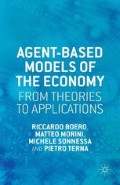Abstract
The chapter, of particular interest to industrial economists, managers, and business consultants, and also to policy-makers, is about the importance of networks and their links with simulation.
Access this chapter
Tax calculation will be finalised at checkout
Purchases are for personal use only
Preview
Unable to display preview. Download preview PDF.
References
Balke, T. and Gilbert, N. (2014). How Do Agents Make Decisions? A Survey. Journal of Artificial Societies and Social Simulation, 17(4), p. 13. http://jasss.soc.surrey.ac.uk/17/4/13.html.
Clarkson, G. P. and Simon, H. A. (1960). Simulation of Individual and Group Behavior. The American Economic Review, 50, pp. 920–932.
De Caux, R., Smith, C., Kniveton, D., Black, R. and Philippides, A. (2014). Dynamic, Small-World Social Network Generation through Local Agent Interactions. Complexity, pp. 44–53. http://dx.doi.org/10.1002/cplx.21528.
Edmonds, B. and Chattoe, E. (2005). When Simple Measures Fail: Characterising Social Networks using Simulation. Presented at the Social Network Analysis: Advances and Empirical Applications Forum. Oxford, UK.
Fontana, M. and Terna, P. (2015). From Agent-based Models to Network Analysis (and Return): The Policy-making Perspective. Department of Economics and Statistics Cognetti de Martiis. Working Papers 201507, University of Turin. https://ideas.repec.org/p/uto/dipeco/201507.html.
Gibbons, R. (2000). Why Organizations Are Such a Mess (and What an Economist Might Do about It). Unpublished manuscript, MIT. http://web.mit.edu/rgibbons/www/index.html.
Greenwald, B. and Stiglitz, J. E. (2014). Creating a Learning Society: A New Approach to Growth, Development, and Social Progress. Columbia University Press, New York.
Hamill, L. and Gilbert, N. (2009). Social Circles: A Simple Structure for Agent-based Social Network Models. Journal of Artificial Societies and Social Simulation, 12(2), p. 3. http://jasss.soc.surrey.ac.uk/12/2/3.html.
Heijnen, P., Chappin, E. and Nikolic, I. (2014). Infrastructure Network Design with a Multi- model Approach: Comparing Geometric Graph Theory with an Agent- based Implementation of an Ant Colony Optimization. Journal of Artificial Societies and Social Simulation, 17(4), p. 1. http://jasss.soc.surrey.ac.uk/17/4/1.html.
Jesi, G.P. and Fioretti, G. (2012), Dissecting and Understanding Supply Chains through Simulation: an Agent-based Approach. In Proc. 1st International Symposium on Applied Research in Technologies of Information and Communication (ARcTIC), Bologna, December 2012, on line at http://jesi.web.cs.unibo.it/papers/ARcTIC12.pdf
Kirman, A. P. and Vriend, N. J. (2001). Evolving Market Structure: An ACE Model of Price Dispersion and Loyalty. Journal of Economic Dynamics and Control, 25(3), pp. 459–502.
Küster, T., Heßler, A. and Albayrak, S. (2014). Towards Process- oriented Modelling and Creation of Multi- agent Systems. In Proceedings of 2nd Workshop on Engineering Multiagent Systems (EMAS 2014).
Rosenblueth, A. and Wiener, N. (1945). The Role of Models in Science. Philosophy of Science, 12(4), pp. 316–321. http://www.jstor.org/stable/184253.
Simon, H. A. (1997). Administrative Behavior. Free Press, New York. First edition, 1965.
Terna, P. (2010). An Agent-based Methodological Framework to Simulate Organizations or the Quest for the Enterprise. In E. Mollona, ed., Computational Analysis of Firms Organisation and Strategic Behaviour. Routledge, London, pp. 247–279.
Weisbuch, G., Kirman, A. and Herreiner, D. (2000). Market Organisation and Trading Relationships. The Economic Journal, 110(463), pp. 411–436.
Copyright information
© 2015 Pietro Terna
About this chapter
Cite this chapter
Terna, P. (2015). Production Organization, Recipes, and Networks, with a Few Steps in Network Analysis. In: Agent-based Models of the Economy. Palgrave Macmillan, London. https://doi.org/10.1057/9781137339812_5
Download citation
DOI: https://doi.org/10.1057/9781137339812_5
Publisher Name: Palgrave Macmillan, London
Print ISBN: 978-1-349-67406-0
Online ISBN: 978-1-137-33981-2
eBook Packages: Palgrave Economics & Finance CollectionEconomics and Finance (R0)

